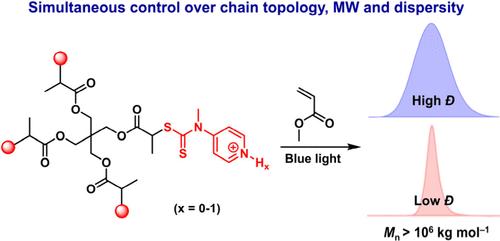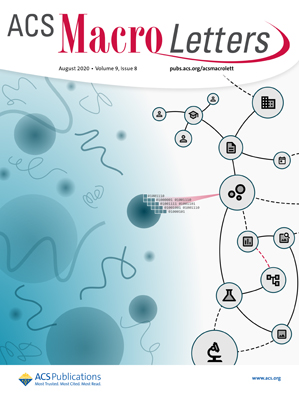Synthesis of Star Polymers with Ultrahigh Molecular Weights and Tunable Dispersities via Photoiniferter Polymerization
IF 5.1
Q1 POLYMER SCIENCE
引用次数: 0
Abstract
Simultaneous control over macromolecular chain topology, molecular weight, and dispersity is an important synthetic goal in polymer chemistry. The synthesis of well-defined poly(methyl acrylate) star polymers with ultrahigh molecular weights (>106 g mol–1) and tunable dispersities is realized for the first time via blue light-controlled photoiniferter polymerization using a tetrafunctional switchable RAFT agent (SRA4). The spectroscopic properties and polymerization activity of SRA4 can be reversibly tuned by addition of acid/base. For example, protonation of SRA4 with 4-toluenesulfonic acid (TsOH) leads to enhanced UV–visible light absorption, a faster polymerization rate, and a lower dispersity for the resulting star polymer. Star polymers were prepared with predicted molecular weights (Mn ≈ 80–1550 kg mol–1) and tunable dispersities (Đ ≈ 1.8–1.2) when targeting degrees of polymerization in the range of 1000–20000 in the presence of varying amounts of TsOH. High end-group fidelity for such star polymers was confirmed by one-pot chain extension experiments, which afforded a series of pseudoblock copolymers with controlled dispersities. Finally, rotational rheology was used to examine the effect of molecular weight, dispersity, and chain topology (whether linear or star-shaped) on solution viscosity.

求助全文
约1分钟内获得全文
求助全文
来源期刊
CiteScore
10.40
自引率
3.40%
发文量
209
审稿时长
1 months
期刊介绍:
ACS Macro Letters publishes research in all areas of contemporary soft matter science in which macromolecules play a key role, including nanotechnology, self-assembly, supramolecular chemistry, biomaterials, energy generation and storage, and renewable/sustainable materials. Submissions to ACS Macro Letters should justify clearly the rapid disclosure of the key elements of the study. The scope of the journal includes high-impact research of broad interest in all areas of polymer science and engineering, including cross-disciplinary research that interfaces with polymer science.
With the launch of ACS Macro Letters, all Communications that were formerly published in Macromolecules and Biomacromolecules will be published as Letters in ACS Macro Letters.

 求助内容:
求助内容: 应助结果提醒方式:
应助结果提醒方式:


